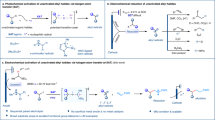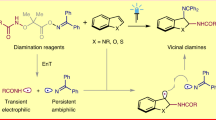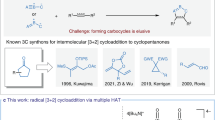Abstract
Chemists extensively use free radical reactivity for applications in organic synthesis, materials science, and life science. Traditionally, generating radicals requires strategies that exploit the bond dissociation energy or the redox properties of the precursors. Here, we disclose a photochemical catalytic approach that harnesses different physical properties of the substrate to form carbon radicals. We use a nucleophilic dithiocarbamate anion catalyst, adorned with a well-tailored chromophoric unit, to activate alkyl electrophiles via an SN2 pathway. The resulting photon-absorbing intermediate affords radicals upon homolytic cleavage induced by visible light. This catalytic SN2-based strategy, which exploits a fundamental mechanistic process of ionic chemistry, grants access to open-shell intermediates from a variety of substrates that would be incompatible with or inert to classical radical-generating strategies. We also describe how the method’s mild reaction conditions and high functional group tolerance could be advantageous for developing C–C bond-forming reactions, for streamlining the preparation of a marketed drug, for the late-stage elaboration of biorelevant compounds and for enantioselective radical catalysis.
This is a preview of subscription content, access via your institution
Access options
Access Nature and 54 other Nature Portfolio journals
Get Nature+, our best-value online-access subscription
$29.99 / 30 days
cancel any time
Subscribe to this journal
Receive 12 print issues and online access
$259.00 per year
only $21.58 per issue
Buy this article
- Purchase on Springer Link
- Instant access to full article PDF
Prices may be subject to local taxes which are calculated during checkout





Similar content being viewed by others
Data availability:
The data supporting the findings of this study are available within the paper and its Supplementary Information. Crystallographic data for Br-11, an analogue of the major diastereoisomer of compound 11, have been deposited with the Cambridge Crystallographic Data Centre, accession number CCDC 1839232.
References
Renaud, P. & Sibi, M. P. (eds) Radicals in Organic Synthesis (Wiley-VCH, Weinheim, Germany, 2001).
Yan, M., Lo, J. C., Edwards, J. T. & Baran, P. S. Radicals: reactive intermediates with translational potential. J. Am. Chem. Soc. 138, 12692–12714 (2016).
Lalevée, J. & Fouassier, J. P. in Encyclopedia of Radicals in Chemistry, Biology and Materials, Vol 1 (eds Chatgilialoglu, C. & Studer, A.) (John Wiley & Sons, Weinheim, 2012).
Yan, M., Kawamata, Y. & Baran, P. S. Synthetic organic electrochemical methods since 2000: on the verge of a renaissance. Chem. Rev. 117, 13230–13319 (2017).
Barton, D. H. R. & McCombie, S. W. A new method for the deoxygenation of secondary alcohols. J. Chem. Soc. Perkin Trans. 1, 1574–1585 (1975).
Barton, D. H. R., Crich, D. & Motherwell, W. B. New and improved methods for the radical decarboxylation of acids. J. Chem. Soc. Chem. Commun. https://doi.org/10.1039/C39830000939 (1983).
Barton, D. H. R. & Zard, S. Z. Invention of new reactions useful in the chemistry of natural products. Pure Appl. Chem. 58, 675–684 (1986).
Delduc, P., Tailhan, C. & Zard, S. Z. A convenient source of alkyl and acyl radicals. J. Chem. Soc. Chem. Commun. https://doi.org/10.1039/C39880000308 (1988).
Zard, S. Z. On the trail of xanthates: some new chemistry from an old functional group. Angew. Chem. Int. Ed. 36, 672–685 (1997).
Studer, A. & Curran, D. P. Catalysis of radical reactions: a radical chemistry perspective. Angew. Chem. Int. Ed. 55, 58–102 (2016).
Shaw, M. H., Twilton, J. & MacMillan, D. W. C. Photoredox catalysis in organic chemistry. J. Org. Chem. 81, 6898–6926 (2016).
Matsui, J. K., Lang, S. B., Heitz, D. R. & Molander, G. A. Photoredox-mediated routes to radicals: the value of catalytic radical generation in synthetic methods development. ACS Catal. 7, 2563–2575 (2017).
Tzirakis, M. D., Lykakis, I. N. & Orfanopoulos, M. Decatungstate as an efficient photocatalyst in organic chemistry. Chem. Soc. Rev. 38, 2609–2621 (2009).
Roth, H. G., Romero, N. A. & Nicewicz, D. A. Experimental and calculated electrochemical potentials of common organic molecules for applications to single-electron redox chemistry. Synlett. 27, 714–723 (2016).
Lalevée, J., Blanchard, N., El-Roz, M., Allonas, X. & Fouassier, J. P. New photoiniferters: respective role of the initiating and persistent radicals. Macromolecules 41, 2347–2352 (2008).
Dag, O., Yaman, S. O., Onal, A. M. & Isci, H. Spectroelectrochemistry of potassium ethylxanthate, bis(ethylxanthato)nickel(II) and tetraethylammonium tris(ethylxanthato)nickelate(II). J. Chem. Soc. Dalton Trans. https://doi.org/10.1039/B105683M (2001).
Bahtia, K. & Schuler, R. H. Oxidation of hydroxycyclohexadienyl radical by metal ions. J. Phys. Chem. 78, 2335–2338 (1974).
Duan, X.-H., Maji, B. & Mayr, H. Characterization of the nucleophilic reactivities of thiocarboxylate, dithiocarbonate and dithiocarbamate anions. Org. Biomol. Chem. 9, 8046–8050 (2011).
Barton, D. H. R., George, M. V. & Tomoeda, M. 369. Photochemical transformations. Part XIII. A new method for the production of acyl radicals. J. Chem. Soc. https://doi.org/10.1039/JR9620001967 (1962).
Grainger, R. S. & Welsh, E. J. Formal synthesis of (−)-Aphanorphine using sequential photomediated radical reactions of dithiocarbamates. Angew. Chem. Int. Ed. 46, 5377–5380 (2007).
Davies, J., Svejstrup, T. D., Fernandez Reina, D., Sheikh, N. S. & Leonori, D. Visible-light-mediated synthesis of amidyl radicals: transition-metal-free hydroamination and N-arylation reactions. J. Am. Chem. Soc. 138, 8092–8095 (2016).
Giese, B. Formation of C–C bonds by addition of free radicals to alkenes. Angew. Chem. Int. Ed. 22, 753–764 (1983).
Proinsias, K. ó, Jackowska, A., Radzewicz, K., Giedyk, M. & Gryko, D. Vitamin B12 catalyzed atom transfer radical addition. Org. Lett. 20, 296–299 (2018).
Gualandi, A. et al. Photocatalytic radical alkylation of electrophilic olefins by benzylic and alkylic zinc-sulfinates. ACS Catal. 7, 5357–5362 (2017).
Ueda, M. et al. Benzyl radical addition reaction through the homolytic cleavage of a benzylic C–H bond. Org. Biomol. Chem. 9, 2062–2064 (2011).
Capaldo, L., Buzzetti, L., Merli, D., Fagnoni, M. & Ravelli, D. Smooth photocatalyzed benzylation of electrophilic olefins via decarboxylation of arylacetic acids. J. Org. Chem. 81, 7102–7109 (2016).
Isse, A. A., Falciola, L., Mussini, P. R. & Gennaro, A. Relevance of electron transfer mechanism in electrocatalysis: the reduction of organic halides at silver electrodes. Chem. Commun. https://doi.org/10.1039/B513801A (2006).
Brasholz, M. “Super-reducing” photocatalysis: consecutive energy and electron transfers with polycyclic aromatic hydrocarbons. Angew. Chem. Int. Ed. 56, 10280–10281 (2017).
Clayden, J., Greeves, N. & Warren, S. in Organic Chemistry (ed. Wothers, P.) Ch. 17 (Oxford University Press, Oxford, 2001).
Blakemore, D. C. et al. Organic synthesis provides opportunities to transform drug discovery. Nat. Chem. 10, 383–394 (2018).
Chen, J.-R., Yu, X.-Y. & Xiao, W.-J. Tandem radical cyclization of N-arylacrylamides: an emerging platform for the construction of 3,3-disubstituted oxindoles. Synthesis 47, 604–629 (2015).
Fujiwara, Y. & Baran, P. S. in New Horizons of Process Chemistry (eds Tomioka K., Shioiri T. & Sajiki H.) (Springer Nature, Singapore, 2017).
Carson, J. R. Uncatalyzed aroylation of 1-alkylpyrrole-2-acetic acid derivatives. US Patent US3998844A (1976).
Liu, Z.-Q. & Li, Z. Radical-promoted site-specific cross dehydrogenative coupling of heterocycles with nitriles. Chem. Commun. 52, 14278–14281 (2016).
Cambié, D., Bottecchia, C., Straathof, N. J. W., Hessel, V. & Noël, T. Applications of continuous-flow photochemistry in organic synthesis, material science, and water treatment. Chem. Rev. 116, 10276–10341 (2016).
Nicewicz, D. & MacMillan, D. W. C. Merging photoredox catalysis with organocatalysis: the direct asymmetric alkylation of aldehydes. Science 322, 77–80 (2008).
Silvi, M. & Melchiorre, P. Enhancing the potential of enantioselective organocatalysis with light. Nature 554, 41–49 (2018).
Neumann, M., Füldner, S., König, B. & Zeitler, K. Metal-free, cooperative asymmetric organophotoredox catalysis with visible light. Angew. Chem. Int. Ed. 50, 951–954 (2011).
Gualandi, A. et al. Organocatalytic enantioselective alkylation of aldehydes with [Fe(bpy)3]Br2 catalyst and visible light. ACS Catal. 5, 5927–5931 (2015).
Brimioulle, R., Lenhart, D., Maturi, M. M. & Bach, T. Enantioselective catalysis of photochemical reactions. Angew. Chem. Int. Ed. 54, 3872–3890 (2015).
Acknowledgements
We thank ICIQ and the European Research Council (ERC 681840 - CATA-LUX) for financial support. E.P.B. thanks MINECO (CTQ2016-75520-P) for a predoctoral fellowship.
Author information
Authors and Affiliations
Contributions
B.S.-C. was involved in the discovery and initial development of the radical generation strategy. B.S.-C., M.A.H., and E.P.B. performed the experiments. All the authors analyzed the data and designed the experiments. P.M directed the project and wrote the manuscript with contributions from all the authors.
Corresponding author
Ethics declarations
Competing interests
The authors declare no competing interests.
Additional information
Publisher’s note: Springer Nature remains neutral with regard to jurisdictional claims in published maps and institutional affiliations.
Supplementary information
Supplementary information
General information, catalyst synthesis, experimental set-up, mechanistic studies, synthetic procedures, additional references and chemical compound characterization data
Rights and permissions
About this article
Cite this article
Schweitzer-Chaput, B., Horwitz, M.A., de Pedro Beato, E. et al. Photochemical generation of radicals from alkyl electrophiles using a nucleophilic organic catalyst. Nature Chem 11, 129–135 (2019). https://doi.org/10.1038/s41557-018-0173-x
Received:
Accepted:
Published:
Issue Date:
DOI: https://doi.org/10.1038/s41557-018-0173-x
This article is cited by
-
C−F bond activation enables synthesis of aryl difluoromethyl bicyclopentanes as benzophenone-type bioisosteres
Nature Communications (2024)
-
Turning sulfonyl and sulfonimidoyl fluoride electrophiles into sulfur(VI) radicals for alkene ligation
Nature Communications (2023)
-
Spotting trends in organocatalysis for the next decade
Nature Communications (2020)
-
N-Substituted pyridinium salts as reagents for radical functionalization using visible light (microreview)
Chemistry of Heterocyclic Compounds (2020)
-
Safe, sustainable and scalable
Nature Chemistry (2019)



